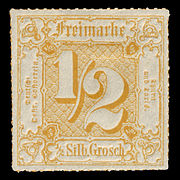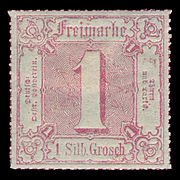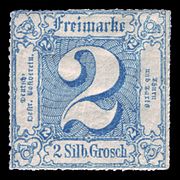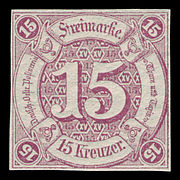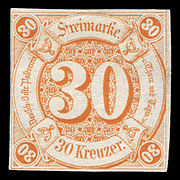Thurn-und-Taxis-Post

As a private company, the Thurn-und-Taxis-Post was the successor to the Imperial Post Office organized by the Thurn and Taxis . The Thurn-und-Taxis-Post with its headquarters in Frankfurt am Main existed from 1806 to 1867 and was operated by members of the Thurn und Taxis family.
The end of the Imperial Postal Service
During the 16th century, the Taxis dynasty was entrusted with the transport of imperial courier mail in the Holy Roman Empire , the Burgundian Netherlands , later the Spanish Netherlands , Spain and Burgundy. In 1595 Leonhard I von Taxis became postmaster general of the empire. Since 1615 the office under Lamoral von Taxis became hereditary. In 1650 the Taxis house was allowed to rename itself to Thurn und Taxis with imperial approval. As a result, the Imperial Post Office was able to assert itself in the competition against the state post offices.
Due to the Revolutionary Wars and the Napoleonic Conquests, the Imperial Post Office lost a large part of its areas of interest under Postmaster General Carl Anselm von Thurn und Taxis . After the death of Carl Anselm von Thurn und Taxis on November 13, 1805, his son Karl Alexander von Thurn und Taxis succeeded him.
After the Peace of Pressburg in December 1805, the operation of the Imperial Post Office in Württemberg was discontinued and continued under state management. In contrast, Karl Alexander von Thurn and Taxis received the Bavarian Post on February 24, 1806 as a feudal throne. On May 2, 1806, a loan agreement between Baden and Karl Alexander von Thurn und Taxis was signed to operate the post office.
The founding of the Rhine Confederation on July 12, 1806 actually meant the end of the Holy Roman Empire and thus also the end of the Imperial Post Office and the Post Generalate of Thurn and Taxis. On August 6, 1806, Franz II laid down the German imperial crown.
The Imperial Post Office , which was organized and directed by the Thurn and Taxis , no longer existed, but Therese Mathilde von Thurn and Taxis tried to keep the Thurn-und-Taxis-Post as a private company in negotiations with the Prince of the Rhine and Napoleon .
The Thurn-und-Taxis-Post
On August 1, 1808, Bavaria took over the state-run postal operations. Baden followed on August 2, 1811. Since Regensburg fell to Bavaria, the Thurn und Taxis post office was relocated to Frankfurt am Main in 1810. After Napoleon's defeat and the first exile, Article 17 of the German Federal Act of June 8, 1815 at the Congress of Vienna confirmed the income of the former Thurn und Taxis post offices in several states of the German Confederation as legitimate claims. States that had set up their own postal service or intended to do so were obliged to pay appropriate compensation.
According to the federal act, the Grand Duchy of Hesse , Nassau , Saxe-Weimar , Meiningen , Coburg-Gotha , the principalities of Reuss and Schwarzburg-Rudolstadt , the Free Cities of Frankfurt , Hamburg, Bremen and Lübeck, the principalities of Hohenzollern , Lippe-Detmold and Schaumburg-Lippe belonged to the now privately operated Thurn- und-Taxis-Post. The headquarters in Frankfurt was confirmed on May 20, 1816.
On May 14, 1816, Karl Alexander von Thurn und Taxis signed a contract with the Elector Wilhelm I of Hesse , who gave his sovereign post as a heir to the princes of Thurn-und-Taxis (see also the Thurn-und-Taxis Treaty Post dated January 23, 1814 with the electoral Hessian post via reciprocal mail transport).
On July 27, 1819, Württemberg transferred ownership and management of its state mail to the Prince of Thurn and Taxis, as the state could not pay the compensation due.
German-Austrian postal association
In 1847 a German postal conference met in Dresden, the work of which led to the conclusion of the German-Austrian postal union agreement, which came into force on July 1, 1850. On April 6, 1850, the Thurn-und-Taxis-Post joined the German-Austrian Post Association, triggering a negative reaction from the Prussian government. Above all, Bismarck, as a representative at the German Confederation in Frankfurt, expressed disapproval.
On March 22, 1851, Württemberg separated from the Thurn und Taxis Post and continued to run the post as a state enterprise.
On January 1, 1852, the Thurn-und-Taxis-Post introduced two variants of postage stamps : Kreuzer and Groschen .
The end of the Thurn-und-Taxis-Post
After the victory in the Austro-Prussian War in 1866, Prussia occupied the Free City of Frankfurt and forced the Thurn und Taxis headquarters to conclude an assignment agreement: in return for compensation, the postal facility had to be left to the Prussian state. The contract was ratified on January 28, 1867, and the delivery took place on July 1, 1867. The last general post director of the Thurn and Taxis Post in Frankfurt was Eduard von Schele zu Schelenburg .
Postage stamps from the Thurn-und-Taxis-Post
The postage stamps existed between 1852 and 1866. The validity ended on June 30, 1867. They were numerical drawings in black letterpress on colored paper by C. Naumann from Frankfurt am Main. The stamps were issued for the northern district in silver groschen (1 Thaler = 30 silver groschen) and in the southern district in Kreuzer (1 gulden = 60 Kreuzer).
- Northern District
- Southern District
Literature (selection)
- Wolfgang Behringer: Thurn and Taxis. Munich 1990, ISBN 3-492-03336-9 .
- Martin Dallmeier: Sources on the history of the European postal system. Kallmünz 1977.
- Martin Dallmeier, Martha Schad: The Princely House of Thurn and Taxis, 300 years of history in pictures. Pustet, Regensburg 1996, ISBN 3-7917-1492-9 .
- Ludwig Kalmus: World History of the Post. Vienna 1937.
- Max Piendl: The Princely House of Thurn and Taxis. Regensburg 1980.
- Heinrich von Stephan : History of the Prussian Post. Berlin 1859. (Reprint Heidelberg 1987)
Web links
Individual evidence
- ↑ Martin Dallmeier, Martha Schad: The Princely House of Thurn and Taxis, 300 years of history in pictures. Pustet, Regensburg 1996, ISBN 3-7917-1492-9 , p. 79; Wording from Max Piendl: The Princely House of Thurn and Taxis. Regensburg 1980, p. 86.





